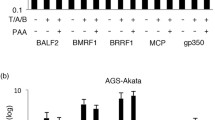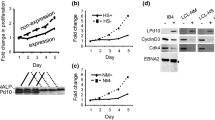Abstract
Epstein-Barr virus (EBV) is a human herpesvirus that is causally associated with several malignancies including nasopharyngeal carcinoma, African Burkitt’s lymphoma, and lymphoproliferative disorders in immunosuppressed people (reviewed in Miller 1985). In vitro EBV infects human B cells and immortalizes between 10%-100% of them (Sugden and Mark 1977; reviewed in zur Hausen 1981). It seems likely that EBV’s capacity to immortalize cells in culture is related to its tumorigenicity in vivo. This likelihood has led researchers to study the mechanism of immortalization of B cells by this virus. The EBV genes required to initiate and/or to maintain the immortalized state in vitro have not been identified. However, at least eight viral genes are found to be transcribed consistently in B cells immortalized in vitro, and circumstantial evidence exists that at least several of these gene products will be required for this process (reviewed in Knutson and Sugden 1988). Until recently, there was no evidence that causally linked any one of these eight viral genes with changes in the growth control of EBV-infected cells. It has now been shown that one viral gene, BNLF-1 (or LMP), when expressed from either of two heterologous promoters and introduced into either of two established rodent cell lines, Rat-1 (Wang et al. 1985) or BALB/3T3 cells (Baichwal and Sugden 1988), induces these cells to grow in an anchorage-independent fashion in agarose.
Access this chapter
Tax calculation will be finalised at checkout
Purchases are for personal use only
Preview
Unable to display preview. Download preview PDF.
Similar content being viewed by others
References
Baichwal VR, Sugden B (1987) Posttranslational processing of an Epstein-Barr virus-encoded membrane protein expressed in cells transformed by Epstein-Barr virus. J Virol 61: 866–875
Baichwal VR, Sugden B (1988) Transformation of BALB/3T3 cells by the BNLF-1 gene of Epstein-Barr virus. Oncogene 2: 461–467
Bankier AT, Deininger PL, Satchwell SC, Baer R, Farrell PJ, Barrell BG (1983) DNA sequence analysis of the EcoRI DHET fragment of B958 Epstein-Barr virus containing the terminal repeat sequences. Mol Biol Med 1: 425–446
Bishop JM (1985) Viral oncogenes. Cell 42: 23–38
Fennewald S, Van Santen V, Kieff E (1984) Nucleotide sequence of an mRNA transcribed in latent growth-transforming virus infection that indicates that it may encode a membrane protein. J Virol 51: 411–419
Hanley MR, Jackson T (1987) News and views. Substance K receptor: return of the magnificent seven. Nature 329: 766–767
Hennessy K, Fennewald S, Hummel M, Cole T, Kieff E (1984) A membrane protein encoded by Epstein-Barr virus in latent growth transforming infection. Proc Natl Acad Sci USA 81: 7207–7211
Knutson JC, Sugden B (1988) In: Klein G (ed) Advances in viral oncology, vol 8. Raven, New York
Lefkowitz RJ, Caron MG (1988) Adrenergic receptors: models for the study of receptors coupled to guanine nucleotide regulatory proteins. J Biol Chem 263: 4993–4996
Liebowitz D, Wang D, Kieff E (1986) Orientation and patching of the latent infection membrane protein encoded by Epstein-Barr virus. J Virol 58: 233–237
Liebowitz D, Kopan R, Fuchs E, Sample J, Kieff E (1987) An Epstein-Barr virus transforming protein associates with vimentin in lymphocytes. Mol Cell Biol 7: 2299–2308
Mann KP, Thorley-Lawson D (1987) Posttranslational processing of the Epstein-Barr virus encoded p63/LMP protein. J Virol 61: 2100–2108
Mann KP, Staunton D, Thorley-Lawson D (1985) Epstein-Barr virus encoded protein in the plasma membranes of transformed cells. J. Virol. 55: 710–720.
Miller G (1985) Epstein-Barr virus. In: Fields BN (ed) Virology. Raven, New York, pp 563–589
Stinski MF, Roehr TJ (1985) Activation of the major immediate early gene of human cytomegalovirus by cis-acting elements in the promoter-regulatory sequence and by virus-specific transacting components. J. Virol. 55: 431–441.
Strader CD, Sigal IS, Register RB, Candelore MR, Rands E, Dixon RAF (1987) Identification of residues required for ligand binding to the ß-adrenergic receptor. Proc. Natl. Acad. Sci. USA 84: 4384–4388.
Sugden B, Mark W (1977) Clonal transformation of adult human leukocytes by Epstein-Barr virus. J. Virol. 23: 503–508.
Wang D, Liebowitz D, Kieff E (1985) An EBV membrane protein expressed in immortalized lymphocytes transforms established rodent cells. Cell 43: 831–840
zur Hausen H (1981) In: Tooze T (ed) DNA Tumor Viruses. Cold Spring Harbor Laboratory, New York, pp 747–795
Author information
Authors and Affiliations
Editor information
Editors and Affiliations
Rights and permissions
Copyright information
© 1989 Springer-Verlag Berlin · Heidelberg
About this paper
Cite this paper
Baichwal, V.R., Hammerschmidt, W., Sugden, B. (1989). Characterization of the BNLF-1 Oncogene of Epstein-Barr Virus. In: Knippers, R., Levine, A.J. (eds) Transforming Proteins of DNA Tumor Viruses. Current Topics in Microbiology and Immunology, vol 144. Springer, Berlin, Heidelberg. https://doi.org/10.1007/978-3-642-74578-2_29
Download citation
DOI: https://doi.org/10.1007/978-3-642-74578-2_29
Publisher Name: Springer, Berlin, Heidelberg
Print ISBN: 978-3-642-74580-5
Online ISBN: 978-3-642-74578-2
eBook Packages: Springer Book Archive




